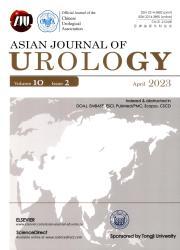泌尿外科中的新型单孔机器人系统:评估前 50 个病例可行性和疗效的前瞻性多中心单臂临床试验
IF 2.4
3区 医学
Q2 UROLOGY & NEPHROLOGY
引用次数: 0
摘要
目的评估SHURUI单孔机器人手术系统在一系列泌尿外科大手术中的可行性和安全性。方法在这项前瞻性、多中心临床试验中,我们检验了SHURUI单端口机器人手术系统在泌尿外科干预中的有效性。首批50名来自中国4个中心的患者接受了舒瑞单孔机器人手术系统的单孔手术,包括部分肾切除术、根治性前列腺切除术、部分肾上腺切除术和肾盂输尿管成形术。该研究的主要终点集中在手术的成功,定义为没有偏离计划手术,不需要超过一个端口,术后24小时内没有再次手术。次要终点包括一系列手术指标、功能结局和患者人口统计数据。术前、出院前、出院后1个月进行临床评估。结果手术顺利进行,无需术中转换或输血。估计失血量和手术时间均保持在令人满意的范围内。对于每种手术,根治性前列腺切除术的平均手术时间和估计失血量分别为179.8(标准差[SD] 39.4) min和125.6 (SD 126.0) mL,部分肾切除术的平均手术时间和估计失血量分别为126.7 (SD 47.8) min和39.2 (SD 54.4) mL,部分肾上腺切除术的平均手术时间和估计失血量分别为112.6 (SD 37.4) min和20.0 (SD 13.2) mL,肾盂输尿管成形术的平均手术时间和估计失血量分别为148.0 (SD 18.2) min和18.0 (SD 17.9) mL。在整个队列中,17例患者共经历了25次不良事件,8例患者遭遇了10次术后并发症,均被评为Clavien-Dindo I级。在试验结束前,所有患者都表现出从这些事件中恢复或改善。结论SHURUI单孔机器人手术系统在泌尿外科大手术中具有可行性和安全性。这些初步发现突出了该系统的潜力,尽管需要进一步的研究和更长时间的随访来评估长期结果。本文章由计算机程序翻译,如有差异,请以英文原文为准。
A novel single-port robotic system in urology: A prospective multicenter single-arm clinical trial evaluating feasibility and efficacy of first 50 cases
Objective
This study aimed to assess the feasibility and safety of the SHURUI single-port robotic surgical system for a range of major urological surgeries.
Methods
In this prospective, multicenter clinical trial, we examined the effectiveness of the SHURUI single-port robotic surgical system in urological interventions. The first 50 patients from four centers in China underwent single-port surgeries including partial nephrectomy, radical prostatectomy, partial adrenalectomy, and pyeloureteroplasty, exclusively by the SHURUI single-port robotic surgical system. The study's primary endpoints focused on the success of surgeries, defined as no deviations from planned procedures, no need for more than one port, and no re-operations within 24 h after surgery. Secondary endpoints encompassed a range of surgical metrics, functional outcomes, and patient demographic data. Clinical assessments were conducted before surgery, before discharge, and 1 month after discharge.
Results
The surgical procedures were executed successfully without requiring intraoperative conversions or transfusions. Both estimated blood loss and operation durations were maintained within satisfactory limits. For each type of surgery, the mean console times and estimated blood loss were 179.8 (standard deviation [SD] 39.4) min and 125.6 (SD 126.0) mL for radical prostatectomy, 126.7 (SD 47.8) min and 39.2 (SD 54.4) mL for partial nephrectomy, 112.6 (SD 37.4) min and 20.0 (SD 13.2) mL for partial adrenalectomy, and 148.0 (SD 18.2) min and 18.0 (SD 17.9) mL for pyeloureteroplasty, respectively. Across the cohort, 17 patients experienced a total of 25 adverse events, while 10 postoperative complications, all rated as Clavien-Dindo grade I, were encountered by eight patients. All patients had shown recovery or improvement from these events before the end of this trial.
Conclusion
The SHURUI single-port robotic surgical system demonstrated feasibility and safety in the performance of major urological surgeries. These initial findings highlight the system's potential, though further research and longer follow-up are required to assess long-term outcomes.
求助全文
通过发布文献求助,成功后即可免费获取论文全文。
去求助
来源期刊

Asian Journal of Urology
UROLOGY & NEPHROLOGY-
CiteScore
4.00
自引率
3.80%
发文量
100
审稿时长
4 weeks
期刊介绍:
Asian Journal of Urology (AJUR), launched in October 2014, is an international peer-reviewed Open Access journal jointly founded by Shanghai Association for Science and Technology (SAST) and Second Military Medical University (SMMU). AJUR aims to build a communication platform for international researchers to effectively share scholarly achievements. It focuses on all specialties of urology both scientifically and clinically, with article types widely covering editorials, opinions, perspectives, reviews and mini-reviews, original articles, cases reports, rapid communications, and letters, etc. Fields of particular interest to the journal including, but not limited to: • Surgical oncology • Endourology • Calculi • Female urology • Erectile dysfunction • Infertility • Pediatric urology • Renal transplantation • Reconstructive surgery • Radiology • Pathology • Neurourology.
 求助内容:
求助内容: 应助结果提醒方式:
应助结果提醒方式:


